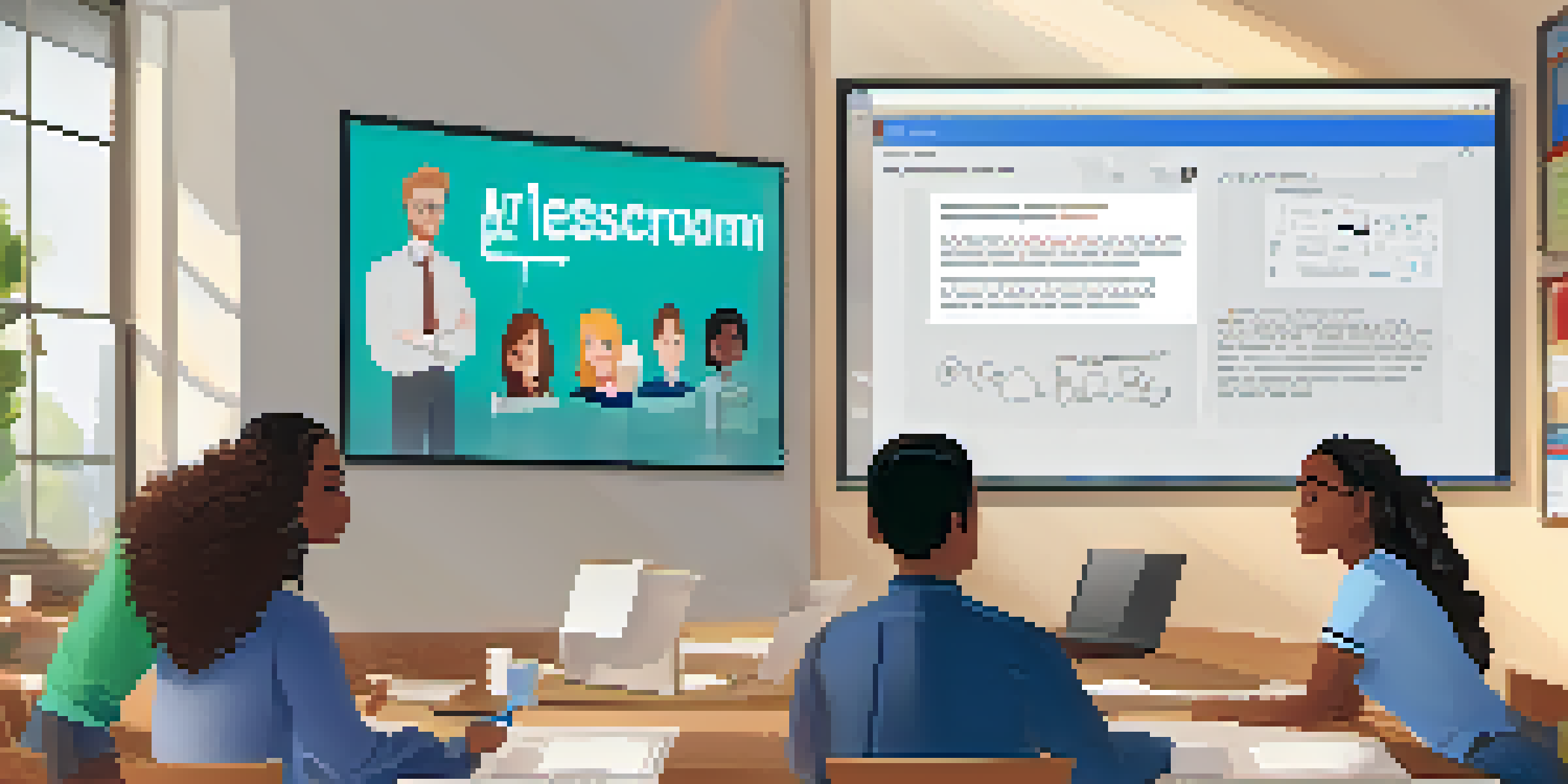Top Cloud-Based Platforms for Collaborative Learning Activities

What is Collaborative Learning and Its Importance
Collaborative learning is an educational approach where students work together to solve problems or complete tasks. This method not only enhances understanding of the material but also fosters essential skills like communication and teamwork. With the rise of digital tools, collaborative learning has become more accessible and engaging, making it a crucial part of modern education.
Alone we can do so little; together we can do so much.
In a world where technology connects us, collaborative learning platforms allow students to interact seamlessly, regardless of location. This connectivity encourages diverse perspectives and ideas, enriching the learning experience. By utilizing these platforms, learners can share insights, ask questions, and support each other in real-time.
Moreover, collaborative learning helps students develop critical thinking skills as they discuss and debate concepts with their peers. It empowers learners to take ownership of their education, promoting self-directed learning. Ultimately, this approach prepares students for the collaborative nature of the modern workplace.
Google Workspace: A Versatile Learning Hub
Google Workspace, formerly known as G Suite, is a powerful set of tools for collaborative learning activities. With applications like Google Docs, Sheets, and Slides, students can create and edit documents together in real-time, making group projects more efficient. The accessibility of these tools on any device ensures that learning can happen anywhere, at any time.

One of the standout features of Google Workspace is its seamless integration with Google Classroom. This platform allows educators to assign tasks, provide feedback, and foster discussions among students. The ease of use and familiarity of Google tools make it a favorite among both teachers and learners.
Collaborative Learning Enhances Skills
Engaging in collaborative learning not only improves understanding of the material but also builds vital skills like communication and teamwork.
Additionally, Google Drive offers ample storage for project materials and resources, making it easy for teams to organize their work. The commenting feature allows for constructive feedback, helping students refine their ideas collaboratively. Overall, Google Workspace stands out as a comprehensive solution for fostering collaborative learning.
Microsoft Teams: A Comprehensive Collaboration Tool
Microsoft Teams has rapidly become a go-to platform for collaborative learning, especially in educational settings. It combines chat, video conferencing, and file sharing in one user-friendly interface, making it easy for students to collaborate on projects. Teams also allows for the creation of channels, enabling focused discussions on specific topics or assignments.
Collaboration allows us to know more than we are capable of knowing by ourselves.
The integration with Microsoft Office applications like Word and Excel adds another layer of functionality. Students can work on documents together, track changes, and provide feedback all within Teams. This holistic approach to collaboration helps streamline the learning process and keeps everyone on the same page.
Moreover, Teams offers robust security features, ensuring that student data is protected. Educators can also monitor participation and engagement during activities, which is crucial for assessing group dynamics. With its extensive range of features, Microsoft Teams is a powerful ally in the collaborative learning landscape.
Slack: Communication at Its Best for Learning Groups
While many associate Slack with business communication, it has become an effective platform for collaborative learning as well. Its channel-based structure allows students to create dedicated spaces for different projects or subjects, fostering organized discussions. The ability to share files and integrate various tools enhances the learning experience.
One of the key benefits of using Slack is its emphasis on real-time communication. Students can ask questions and receive instant feedback from peers or instructors, promoting an interactive learning environment. This immediacy helps to maintain engagement and ensures that learners feel supported throughout their projects.
Digital Tools Facilitate Collaboration
Platforms like Google Workspace and Microsoft Teams provide seamless integration for real-time collaboration, making it easier for students to work together from anywhere.
Additionally, Slack's integrations with other apps, like Google Drive and Trello, allow for a more streamlined workflow. Students can easily link resources and track project progress, making collaboration efficient. Ultimately, Slack stands out as a dynamic tool for enhancing collaborative learning activities.
Miro: Visual Collaboration for Creative Projects
Miro is an online collaborative whiteboard platform that has gained popularity in educational settings. Its visual approach encourages creativity and brainstorming, making it ideal for collaborative projects. Students can draw, add sticky notes, and organize ideas in a way that traditional documents can't match.
The platform offers various templates tailored for different activities, from mind mapping to project planning. This flexibility allows students to approach tasks from multiple angles, fostering innovative thinking. Miro also supports real-time collaboration, so learners can contribute simultaneously, enhancing teamwork.
Furthermore, Miro's integration with various tools like Slack and Google Drive makes it easy to incorporate into existing workflows. This adaptability ensures that Miro complements other collaborative platforms rather than replacing them. Overall, Miro serves as a fantastic resource for groups looking to bring their ideas to life visually.
Padlet: Interactive Boards for Engaging Learning
Padlet is a unique platform that allows users to create interactive boards for collaboration and sharing ideas. It’s incredibly user-friendly, making it accessible for learners of all ages. Students can post notes, images, links, and videos on a virtual wall, promoting engagement and creativity.
One of the standout features of Padlet is its versatility; it can be used for brainstorming, project planning, or even collecting feedback. This flexibility makes it suitable for various subjects and learning styles. Students can collaborate in real-time, helping to build a sense of community within the classroom.
Choosing the Right Platform Matters
Selecting the appropriate collaborative platform is crucial for enhancing the learning experience and should involve input from students to foster engagement.
Additionally, Padlet allows for customization, enabling users to choose different layouts and backgrounds for their boards. This personal touch can enhance the learning experience, as students take ownership of their contributions. Overall, Padlet is an excellent tool for fostering collaborative learning in a fun and interactive way.
Trello: Organizing Group Projects Made Easy
Trello is a project management tool that can significantly enhance collaborative learning activities. Its card and board system allows students to visually organize tasks and responsibilities, making group projects more manageable. Each card can represent a task, and students can add comments and checklists to track progress.
This visual organization helps students break down complex projects into smaller, actionable steps. By assigning tasks to team members, Trello fosters accountability and encourages collaboration. The ability to see everyone's contributions in real-time enhances communication and keeps projects on track.

Furthermore, Trello integrates with various tools like Google Drive and Slack, making it a versatile addition to any learning environment. Its user-friendly interface ensures that students can focus on collaboration rather than navigating a complicated system. Ultimately, Trello is a valuable platform for promoting effective teamwork in educational settings.
Choosing the Right Platform for Your Learning Needs
With so many cloud-based platforms available for collaborative learning, choosing the right one can feel overwhelming. Each tool has its unique features and strengths, so it's essential to assess the specific needs of your group. Consider factors like ease of use, integration capabilities, and the types of activities you'll be engaging in.
For example, if your focus is on visual collaboration, Miro or Padlet might be your best bet. On the other hand, if streamlined communication and file sharing are priorities, Google Workspace or Microsoft Teams could be more suitable. Ultimately, the right platform should enhance, not hinder, the collaborative process.
Moreover, it's important to involve students in the decision-making process. Allowing them to explore different tools can foster a sense of ownership and engagement. By selecting the right collaboration platform, you can create a more effective and enjoyable learning experience for everyone involved.